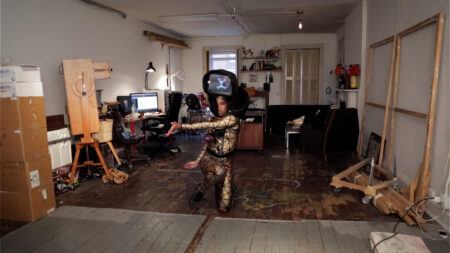Interview
Projecting Fictions: “Insurrection! Our Tools Were Rudimentary, Yet We Pressed On”
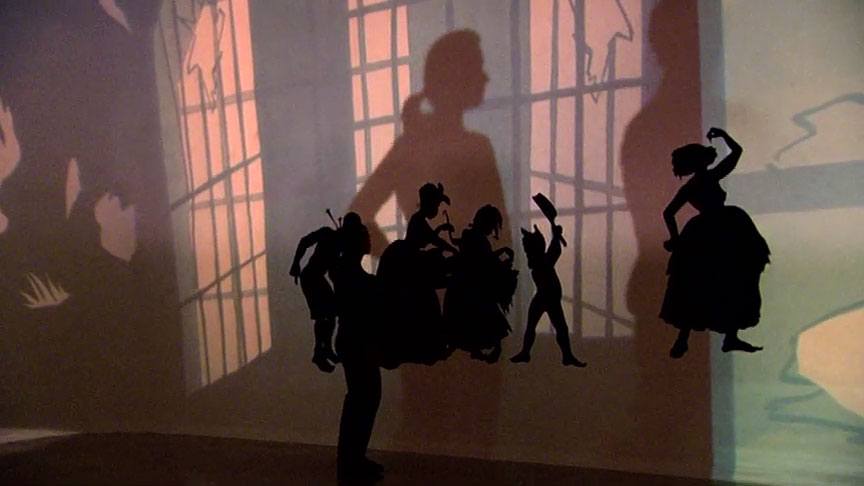
Installation view of Insurrection! (Our Tools Were Rudimentary, Yet We Pressed On) (2002) at the Solomon R. Guggenheim Museum, New York, 2002. Production still from the Art in the Twenty-First Century Season 2 episode, Stories. © Art21, Inc. 2003.
Kara Walker discusses her 2002 exhibition at the Guggenheim Museum, Insurrection! (Our Tools Were Rudimentary, Yet We Pressed On).
ART21: What are your first thoughts about this piece here, at the Guggenheim?
WALKER: Well, this piece is called Insurrection! Our Tools Were Rudimentary, Yet We Pressed On. I always wind up going back to the very beginning of everything with my pieces, so it seems like it’s a continuation of a series of work that I’ve been doing—with large, narrative silhouette scenes, building around this idea of the cyclorama or a kind of historical exhibit. In this case, it’s somewhat hysterical. The idea at the outset was an image of a slave revolt at some point, prior to me. And it was a slave revolt in the antebellum South, where the house slaves got after their master with their instruments, their utensils of everyday life. And really, it started with a sketch of a series of slaves disemboweling a master with a soup ladle. My reference, in my mind, was the surgical theater paintings of Thomas Eakins and others.
ART21: And the overhead projectors came about . . . how?
WALKER: I knew for a while that I wanted to make a piece that tried to engage the space a little bit more directly than the pieces that are just cut paper on the wall. And I had been using the overhead projectors as a kind of a shadow-play tool. (Not really as a tool for making the work—they’re usually hand-drawn.) But I wanted to activate the space, in a way, and have these overhead projectors serve as a kind of stand-in for the viewer, as observers. And my thinking about the overhead projectors connected with my thinking about painting—as far as creating an illusion of depth, but in a very mundane, flat, almost didactic way.
But, back to surgical theater . . . Before I even started working with a narrative that circled around representations of blackness, representations of race, racial history, minstrelsy, and everything that I wanted to investigate, I was making work that was painterly and about the body and the metaphorical qualities of the body. So, I always think about this work and think about history in terms of the body.
And this act of excavating that’s been such a current and recurring theme—particularly in the histories of feminist artists, feminist writers, African-Americans, people of color—is about investigating and eviscerating this body of a collective experience, a history, sometimes to the point (at least in my reckoning) to the point of leaving nothing intact. There’s just this pile of parts and goo. And I entered into this project, this idea of being a black woman artist, from the perspective of a person who has been presented with a pre-dissected body to work from, a pre-dissected body of information. These gall bladders and hearts and stomachs are all the things that would make me complete, should I choose to use them correctly and put them back together. So, in a way, it’s Frankenstein-like.
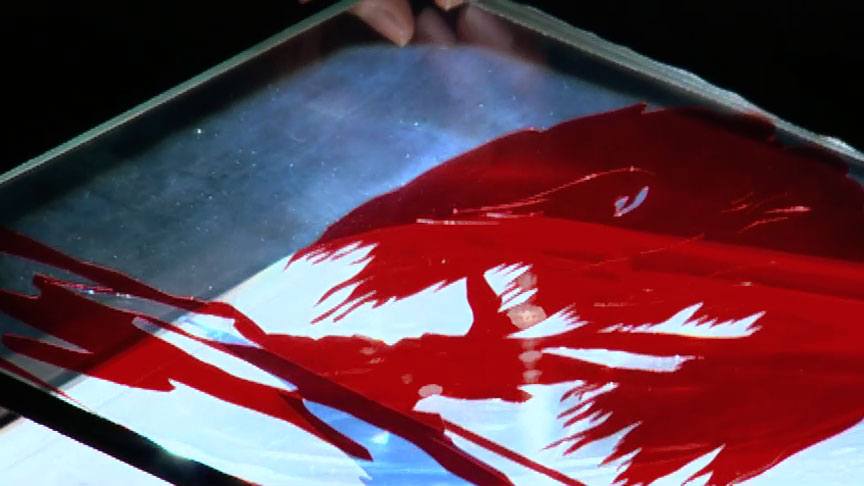
Kara Walker installs For the Benefit of All the Races of Mankind (Mos Specially the Master One, Boss) An Exhibition of Artifacts, Remnants, and Effluvia EXCAVATED from the Black Heart of a Negress III (2002) at the Tang Museum, Saratoga Springs, NY, 2003. Production still from the Art in the Twenty-First Century Season 2 episode, Stories. © Art21, Inc. 2003.
ART21: Do your pieces, like Insurrection, always have a particular narrative that you want viewers to follow?
WALKER: Actually, talking through my work has been one of those problems. There’s a way in which I’m more interested in what viewers bring to this iconography that I’m constantly dredging out of my own subconscious. And as I dredge, I’m often surprised about what comes up and what seems an up-holding of my own invention—what seems connected to a series of representations of the vulgar as paired with the blackness that have already existed and have been regurgitated over several hundred years, or over a history of African-Americana. So, I couldn’t really name these characters or caricatures in the way that the wall texts at the museum or reviewers who’ve looked at my work have sought to, or have elected to. I think these figures are phantom-like. They’re fantasies. They don’t represent anything real. It’s just the end result of so many fabrications of a fabricated identity.
ART21: And yet, your own name often appears in the title of your works, as well. Are you treating yourself as a fictional character?
WALKER: I think part of that is a game that I’ve played with—the naming of the pieces and the way that I’ve sort of represented myself as the maker of these images, always with this jab at the notion of privilege or entitlement as it’s been doled out occasionally to young women in my position: African-American, female, young. I was interested in slave narratives and the romantic novel of, now, one hundred fifty years ago.
When Phillis Wheatley’s book of poems had to be verified by upstanding white men in the community, and they put their stamp of approval on the authenticity of these words, as though it were an impossibility that a black woman could think of anything on her own . . . Now, it’s debatable, you know, how artistically worthy what she thought of on her own was, but that’s really not the point. I like the idea of suddenly finding myself in the desirable echelons of the art world and presenting myself in this manner. So, I am incredibly grateful for the approval of white society, who understands that I am an anomaly. It should raise questions, I think, maybe more than it does.

Kara Walker installs For the Benefit of All the Races of Mankind (Mos Specially the Master One, Boss) An Exhibition of Artifacts, Remnants, and Effluvia EXCAVATED from the Black Heart of a Negress III (2002) at the Tang Museum, Saratoga Springs, NY, 2003. Production still from the Art in the Twenty-First Century Season 2 episode, Stories. © Art21, Inc. 2003.
ART21: It seems like you keep a lot of information in your mind, simultaneously—numerous perspectives.
WALKER: There’s a lot of information, but it’s not nearly as researched as I want it to be. It depends, really, from piece to piece and from moment to moment in my life. Things have sped up so much, with the career aspect of being an artist, that I always have my suspicions that that’s to keep me out of the books. But no, it’s twofold, you know. There’s a way that this work is two parts research and one part paranoid hysteria. And I’ve always kind of liked that impulse. I’ve always possessed that impulse of concocting half-baked theories based on the reading of a selective tome—I mean, I don’t trust it. I don’t want to put it out there without some self-consciousness, without being reflective about it. But it’s a fascinating slippery slope, when you start.
When I started investigating my relationship to my identity and what my identity means, it was in the context of artists doing identity-based art. I envy and have a love for people who research in great detail history or some moment in history (say, feminist history), and then present it in a way that’s somewhat didactic and matter-of-fact—and, really, with an effort, a sincere effort to throw meaning out to an audience that, maybe, isn’t conscious of this aspect of history. But I’m incredibly suspicious of that impulse, too. I think that it’s all going to be filtered through one’s subjectivity. And my subjectivity—as a young person, as a person at the end of the twentieth century—my subjectivity is of a sexual woman, as a person who makes sometimes really bad decisions. There was no nobility in trying to do research like that, and in trying to filter my sense of self through the lens of a larger history. It was going to get complicated, and I liked the complications that I was finding.
ART21: Where does Insurrection fit, with the more recent projection works?
WALKER: This is the first piece I did. I used the projection and overhead projectors as a feature. And I exhibited it in Geneva, at the Center for Contemporary Art there. I built the piece in a very painterly way. It’s actually the antithesis of the way that I think that I should work: starting with the backgrounds and moving to the foreground and then reworking the backgrounds, and basically cutting and pasting these colored gels, and drawing on the top, and slapping them on top of the overhead projectors in a very slapdash way.
The images, they grew around this central piece with the surgical theater or whatever you want to call it—evisceration, insurrection—and I decided to build it into a triptych based on the space that I had at the time. All of the pieces that I worked on have transformed, depending on the space where they’re exhibited. But this one was built as a triptych with the indoor scene in the center. The windows came on top of that. And then I thought I’d have what’s going on, on the outside, and try to reduce the mayhem that I was envisioning to a few set incidences, where there is some turbulence, there’s some give and take: castration and self-castration, offerings and stealing.
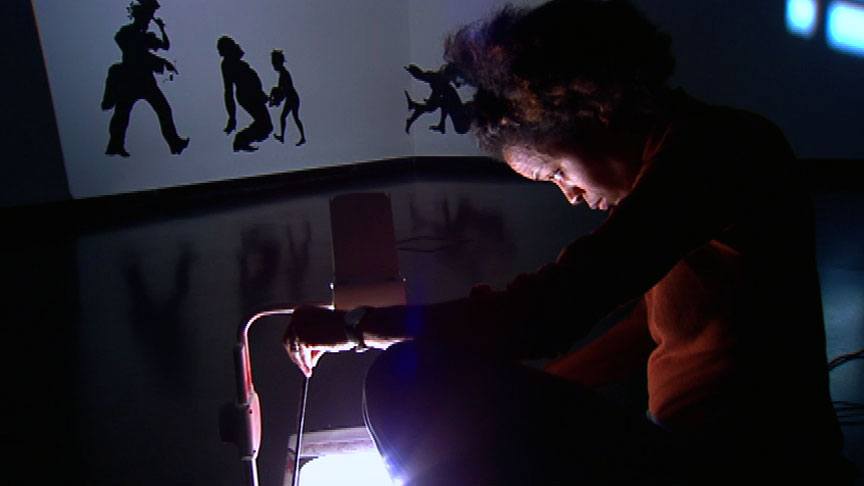
Kara Walker installs For the Benefit of All the Races of Mankind (Mos Specially the Master One, Boss) An Exhibition of Artifacts, Remnants, and Effluvia EXCAVATED from the Black Heart of a Negress III (2002) at the Tang Museum, Saratoga Springs, NY, 2003. Production still from the Art in the Twenty-First Century Season 2 episode, Stories. © Art21, Inc. 2003.
ART21: What do the projections mean to you?
WALKER: Projections came about as one of a series of steps. It’s an easy answer to the idea of projecting—projecting one’s desires, fears, and conditions onto other bodies, which all of my work has tried to engage with, using the silhouette. And it also created a space where the viewer’s shadow would also be projected into the scene—so that, maybe, they would, you know, become captured and implicated in a way that is very didactic. Overhead projectors are a didactic tool; they’re schoolroom tools. So, they’re about conveying facts. The work that I do is about projecting fictions into those facts.
ART21: And the fact that they’re beautiful—how does that play out?
WALKER: Beauty is just an accident. Beauty is just a happenstance. Beauty is the remainder of being a painter. The work becomes pretty because I wouldn’t be able to look at a work about something as grotesque as what I’m thinking about and as grotesque as projecting one’s ugly soul onto another’s pretty body, and representing that in an ugly way. I have always been attracted to the lure—work that draws a viewer in through a kind of seductive offering: “Here’s something to look at. Stay a while.”
ART21: Did you discover something for yourself, when creating this piece?
WALKER: Have I discovered something for myself? Well, this way of working was new, with the projections. It was actually a lot of formal discoveries. Spatial relationships, things like that.
I think one of the things that’s happened here and there with the work that I’ve done is, because it mimics narrative—and narrative is kind of a given when it comes to work that’s produced by black women in this country—is there’s almost an expectation. I feel an expectation for something cohesive. There’s an understanding within America about where that resolution is. You know what that means: to have a Color Purple scenario, where things resolve, in a way; and a female heroine actualizes through a process of self-discovery and historical discovery, and comes out from under her oppressors, and maybe doesn’t become a hero but is a hero for herself.
And nothing ever comes of that, in the pieces that I’m making. And I’m increasingly aware of wanting to make that clear: that, to some extent, there’s a failure for that kind of resolution, and she doesn’t become a . . . You know she’s not evil. She’s not a hero either, but then she sort of engages these oppositions constantly and keeps it open, always knowing that the next question is: “Who is she?”
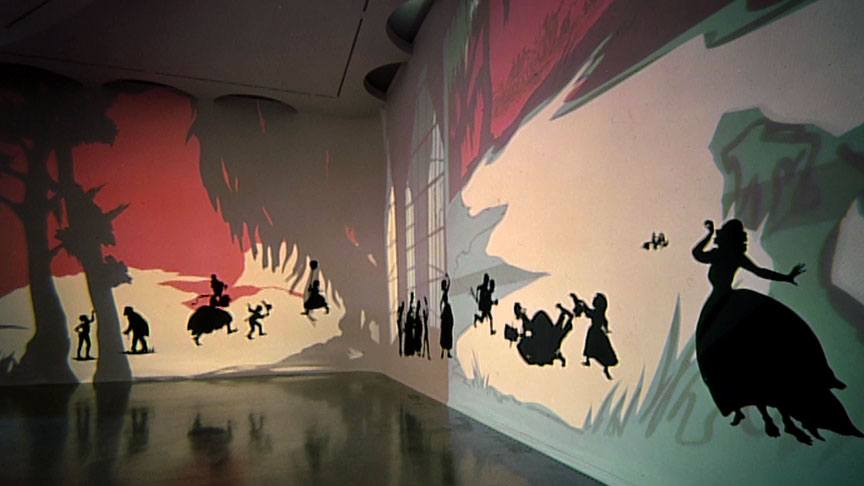
Installation view of Insurrection! (Our Tools Were Rudimentary, Yet We Pressed On) (2002) at the Solomon R. Guggenheim Museum, New York, 2002. Production still from the Art in the Twenty-First Century Season 2 episode, Stories, 2003. © Art21, Inc. 2003.
And she is—I just say she is dot, dot, dot. That’s where I have this problem with language and naming, right now: the Negress of earlier titles, the “Negress of noteworthy talent”—who is me, who is not me, who is that entity of somewhat powerful sisterhood negritude—that is an idealization that stems partially out the Black Power movement and partially out of a mainstream desire for the juicy, strange Other, the Josephine-Baker-banana-skirt kind of desire. Otherness embodied, and Otherness that embodies herself, and Otherness that plays at Otherness. But who is she? Is she one or all of the characters in the work?
I think of the work in the way that you have dream images, and the door and the hippopotamus actually represent the same thing. They’re all stemming from the same impulse, somehow, which is something like a will toward chaos or a will toward attempting resolution, with the certainty that chaos reigns.
This is so hard. Yes, she’s an idealization, disembodied, and also a re-embodied presence, with a will and a desire towards chaos. There is a will towards resolving that chaos with a certainty that it will never quite end. It will never quite reach a clear conclusion. It will progress.
This interview was originally published on PBS.org in September 2003 and was republished on Art21.org in November 2011.
